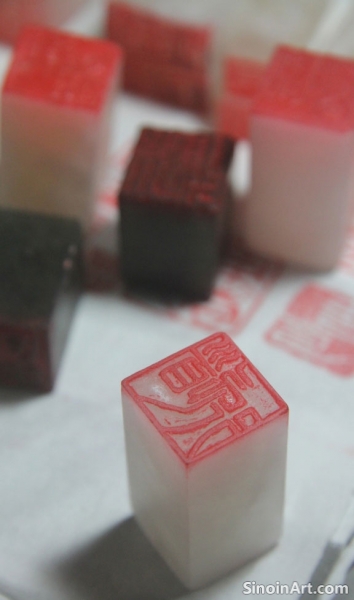Contemporary Name Seal Carving: Preserving Tradition and Embracing Innovation
|
Despite the rapid modernization of society, the art of name seal carving remains a vital part of Chinese culture. Contemporary seal carvers are dedicated to preserving the traditional techniques while also exploring new possibilities for artistic expression. This balance between tradition and innovation ensures that zhuanke continues to evolve and thrive in the modern world. Contemporary carvers are working to preserve the traditions, while also adapting them to modern sensibilities.  Many contemporary seal carvers adhere to the traditional techniques and principles of zhuanke, using the same tools, materials, and calligraphic styles as their predecessors. This commitment to tradition ensures the preservation of the art form's rich heritage. It is important to these modern artists to maintain the traditional practices, to ensure they are not lost.  At the same time, contemporary seal carvers are also exploring new avenues for creative expression. They are experimenting with new materials, techniques, and designs, pushing the boundaries of zhuanke and expanding its reach into the modern art world. Modern carvers explore new techniques and styles, while maintaining the core traditions of the art.  The rise of digital technology has also impacted contemporary seal carving. Some carvers are using digital tools to design and plan their seals, while others are experimenting with new materials and techniques made possible by technology. These innovations allow the carvers to explore new methods of artistic creation. Despite the changes and innovations, the core essence of zhuanke remains the same: to create a unique personal expression that reflects the individual's identity, values, and artistic sensibility. This connection to tradition ensures that the art remains relevant and meaningful. Contemporary seal carvers represent a continuation of a rich artistic tradition. By balancing the old with the new, they ensure that the art of name seal carving will continue to be a vibrant and integral part of Chinese culture for generations to come. They ensure that the traditions of seal carving continue to evolve, while maintaining the core values of the art form. |
Tag : Contemporary Seal Carving, Modern Zhuanke, Traditional Chinese Art, Artistic Innovation, Seal Art Today
Related information
- The Modern Practice of Chinese Seal Carving: Reimagining Tradition
- Collecting Collector's Seals: A Journey Through Art History and Connoisseurship
- Tools of the Trade: Essential Equipment for Seal Carving
- Collecting Name Seals: Understanding Value, Rarity, and Provenance
- The World of Collector's Seals: An Introduction to Shoucang Yinzhang
Explore the modern practice of Chinese seal carving. Discover how contemporary artists are reimagining tradition and incorporating new techniques and styles while respecting its ancient roots.
This article explores the personal journey of those who collect collector’s seals, emphasizing the blend of artistic appreciation, historical research, and personal engagement with Chinese art and culture.
This article explores the essential tools and materials used in Chinese seal carving, focusing on the importance of carving knives, stones, ink pads, and other specialized equipment.
This article provides a guide to collecting Chinese name seals, discussing how to assess their value, understand their rarity, and research their provenance, with tips on how to avoid forgeries.
This article introduces the concept of Chinese collector's seals, exploring their historical role, cultural significance, and how they function as marks of ownership and connoisseurship.